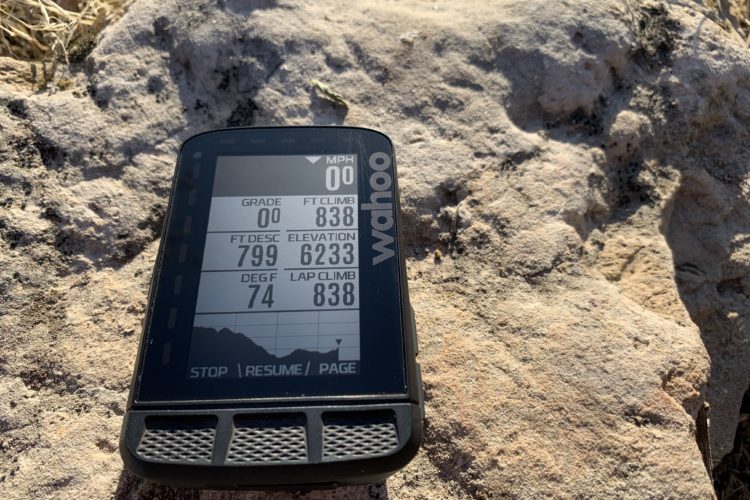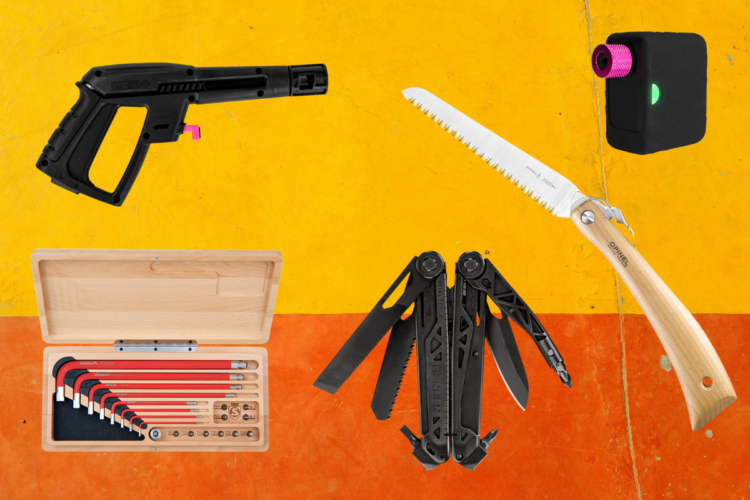
I was an early Wahoo convert when the ELEMNT bike computer first came out in 2016. I ditched my Garmin Edge and never looked back. Instead, I continued with Wahoo, upgrading to the Wahoo Bolt and the Wahoo Roam.
In my opinion, for turn-by-turn navigation — especially on remote gravel roads — and overall user-friendliness, they are simply the best cycling computers out there. Not ony that, despite being made for cycling, the Wahoo computers have gone with me on hikes, cross country skiing, and runs. If only Wahoo made some sort of wrist strap, the Bolt would make a great watch for multi-sport, too.
So, you can imagine my excitement when Wahoo launched their first watch, the Wahoo Rival, in November of last year.
Well, I got my hands on one and have spent the last winter months wearing it on road and mountain bike rides as well as on some runs.

Wahoo rival – Deets
The Wahoo Rival retails for $379.99 $249.99 (currently on sale at Competitive Cyclist), and comes in two colors: Stealth Grey and Kona White.
Advertised as a “radically simplified multisport watch,” I’ll agree that “clean” and “simple” were my first unboxing impressions. With no touch screen and just three small buttons alongside the unit, the design is simple. The unit itself is large — nearly 2” in diameter — yet also surprisingly light at just 52 grams on my kitchen scale. My everyday watch for the past two years has been the Garmin Fenix 5S Plus that weighs a noticeable 15 grams more.
This is Wahoo’s first foray into the wearables market, and they swung for the fences straightaway, targeting one of the biggest consumers of multisport watches: triathletes. The Rival’s hero function is a touchless transition mode that seamlessly changes the sport modes on the watch between swimming, biking, and running. This is perhaps of little use to us mountain bikers unless there are some XTERRA athletes among us who’d be keen to track their splits.

Paired with the free ELEMNT companion app, setup is an absolute breeze. Like all other Wahoo products, it’s very user-friendly, and the pages, activity tracking, clock face and even the buttons are customizable — which is really neat.
While a tad limited, the App interface and watch display offer the same intuitive and user-friendly functionality that so many have come to appreciate about Wahoo’s bike computers.
The weight of the watch, the shape, and the soft, flexible straps make it instantly comfortable to wear, and it continues to feel very natural even when worn 24/7.
Now on to the features.

What it can do
In short: this is a GPS training watch with a heart rate sensor, multisport workout tracking, and a claimed battery life of 24 hours running GPS, and 14 days standby. Specific features include:
- Large, clean exterior with a 64-color, 240x240px display screen and an impact-resistant Gorilla Glass lens.
- Optical Heart Rate sensor with 24×7 tracking.
- Data tracking without the use of an external sensor includes: speed, distance, workout time, swim lengths, pace, stroke count, stroke rate, SWOLF.
- Multisport Handover: Rival connects seamlessly with Wahoo GPS bike computers. This feature enables the bike computer to display your cumulative workout metrics from the watch, while you still retain control of the head unit itself.
- Kickr smart trainer control: you can use the watch to control your Kickr smart trainer modes.
- Bluetooth & ANT+ connection with other devices such as bike computers, treadmills, and 3rd party apps to broadcast your heart rate, cadence, and pace data.
- Supports running and cycling power meters like Stryd
- Supports Running Dynamics from Wahoo TICKR-X
- Multisport mode: touchless transition allows the watch to automatically transition through the different legs of the triathlon, from swim, bike to run, without having to interact with it other than at the start and finish.
- Timer
- Stopwatch
- Customizable Display and Data Fields
- Ambient light sensor: Automatically adjusts the watch screen display for optimal visibility both indoors and outdoors.
- Barometric altimeter
- Water-resistant to 5ATM (50 meters)
- Live tracking when paired with a phone
- Uploads activities to 3rd party sites like Strava, TrainingPeaks, etc
- Smart notifications: on-screen pop-up alerts to notify you of calls, texts, emails, etc. NOTE: these are read-only. No response options.
- Exchangeable wrist straps.
Aside from the weight and comfortable fit, my favorite thing about this watch is its long battery life. As someone who wears her watch 24/7, a 14-day standby battery life is a huge plus.
The fact that the Rival seamlessly transmits, broadcasts, and accumulates workout data between the watch, your bike computer, and other devices through its “Multisport Handover” feature is really cool. For example, your watch can connect with and display the data from your bike’s power and cadence meters, and likewise, the computer unit will display the heart rate data from the watch’s optical heart rate sensor. This could potentially negate the need to wear a heart rate strap.
In the ELEMNT companion app, you can choose from a host of different activity profiles so you can base your display data on whether you’re cycling, running, swimming, doing yoga, strength training etc.
The touchless transition function is an interesting bit of technology, however, it really only applies to duathletes and triathletes. I did try it, of course. And in a small trail run and mountain bike ride test, the watch was quick to detect the transition between running and riding.
If you carry your phone with you, smart notifications will alert you to text messages, calls and email. And luckily, that is a function that can also be turned off.
The display light automatically adjusts for optimal visibility both indoors and outdoors, which is a nice touch and yet another way Wahoo is allowing you to just focus on your activity and nothing else.
When all listed out, the features may seem like a lot, but it’s actually pretty basic for a multisport watch. Compared to a smart watch that one wears 24/7, it may even fall a bit short.
Of course, Wahoo was upfront about the Rival being a radically pared-down computer, aimed at elite athletes who aren’t looking for extra bells and whistles. But is it enough?
What it doesn’t do (and I wish it did)
- No proper reporting of your 24/7 step count and heart rate.
- No sleep tracking.
- No stairs climbed.
- No alarm clock. (How will I make it out of bed for my workout?)
- No turn-by-turn navigation (which I have come to love so much on the Wahoo bike computers).
- No compass or navigation of any kind, in fact.
- No maps or breadcrumbs.
- No workout alerts like zone, cadence, or speed notifications.
- No music.
- No third party apps like payments, weather, etc.
- No Strava Live Segments on device.
- No training load or recovery metrics.
- No touchscreen.
As a long time Garmin watch wearer, the big ones for me are the missing alarm clock — plain handy! —, the lack of sleep data, and the fact that there’s no way to go back and look at your long term step and heart rate data. The unit will measure and record heart rate and steps 24/7, however, the app has no feature to allow you to go back and look at it. You can sync the watch with third party apps but the data reporting is spotty at best.
I was also bummed to learn that there are no maps or navigation on this watch, which is one of the things that made me fall in love with Wahoo in the first place. It’s a technology that they do so well in their bike computers and it seems like a missed opportunity when it comes to their Rival. But again, that is not what Wahoo set out to do and it’s likely we will see that technology added in future Wahoo wearable products.
For now, this watch is made purely for working out.

Wahoo rival – Issues
In a paired-down watch, I expect the product to excel at the things it does do. Now, I already mentioned the good, like the handover feature, the long battery life and the touchless transition. So now, on to the not-so-good.
Reception: I had terrible luck getting the watch to lock in on GPS satellite reception. Whether it was at my house or at a trailhead, it took the watch significantly longer than my Wahoo bike computers or Garmin watch. The latter is interesting because, as I understand it, the Rival makes use of the same Sony GPS chipset as the Garmin.
In testing this watch, I always had my Wahoo ELEMNT Roam bike computer, my Garmin Fenix 5s watch, and the Wahoo Rival watch running simultaneously, and the data was never the same. I would frequently run out of patience and get my activity started before the watch had locked in on the satellites. The watch would usually connect about a half or three-quarters of a mile later and back-populate the data.
In doing so, it also thinks I am faster than my Wahoo ELEMNT Roam does. The watch data would lead to new PRs that my Roam didn’t display. We are talking mere seconds here but on Strava that can be a difference between a cup or no cup.
I noticed that compared to the Fenix 5s, the Rival is very generous with its steps — helping me reach my 10,000 steps goal much faster than my other watch displayed.
The Optical Heart Rate data was fairly similar to data displayed by my Garmin watch, though blippy — jumping from 165 to 78 in a second. Wrist heart rate data is rarely as accurate as chest strap data, so serious data crunchers should probably stick to a chest strap.
Conclusion
Overall, my impression was, well… “Meh”. I wanted to be WOW-ed by yet another Wahoo product, but this one fell short for me. I’m definitely excited to see what Wahoo can do in the wearables space but for cycling. I don’t think the Wahoo ELEMNT Rival can replace or compete with a bike computer such as their own Wahoo ELEMNT Bolt or ELEMNT Roam just yet.
- Price: $
330$249.99 - Available at Competitive Cyclist and other online retailers




















0 Comments